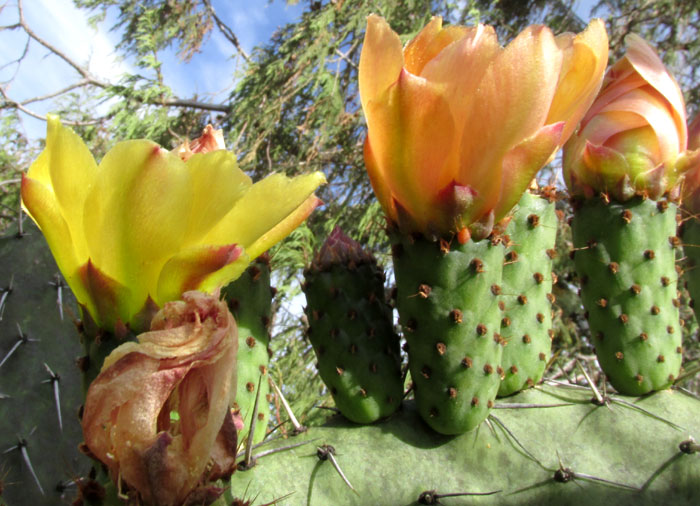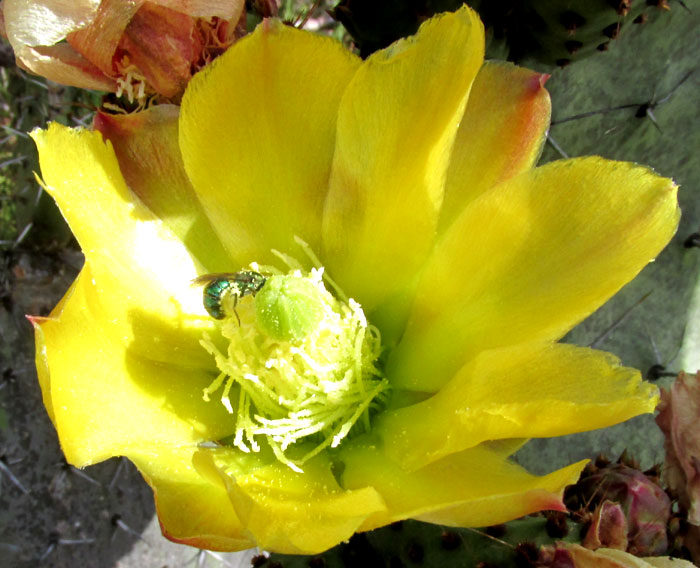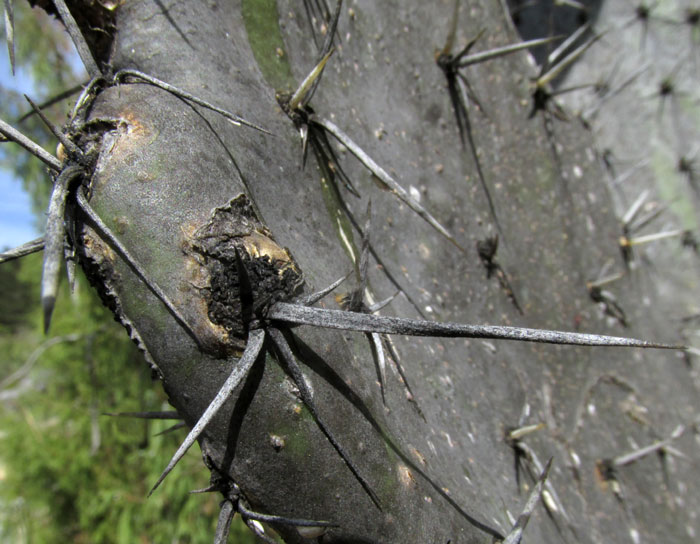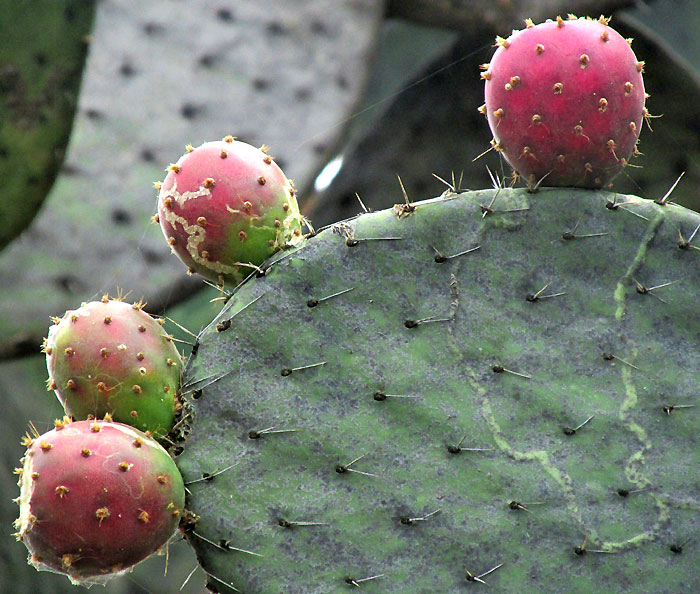Excerpts from Jim Conrad's
Naturalist Newsletter
entry from field notes dated April 17, 2022, taken in disturbed/reforesting borderline cloudforest within 1km of Valle de los Fantasmas, elevation ±2,320m (7600 ft), with limestone bedrock; about 40kms (24 miles), straight-line, ESE of San Luis Potosí, San Luis Potosí state, MÉXICO, (N22.06°, W100.62°)
CARDONA PEAR FLOWERING

Now at the end of the dry season, before the rains have returned, in thin soil among limestone boulders and smaller rocks on the valley's slope, the above 3.5m-tall (12ft) pricklypear cactus turned up flowering. Unlike some pricklypear species, the flowers on this one tended to cluster closely with one another atop the topmost pads, shown below:

They were mainly yellow, but were suffused with pinkness when the corollas were first opening, and when they were old, as shown below:

However, when the blossoms were fully open and receiving pollinators, they were almost completely bright yellow:

The cactus's spine clusters showed some distinctive features.

Pricklypear species often have yellowish or whitish spines, but these are dingy, though you can see that the darkness consists of small spots on other whitish spines. The spots probably are fungus, since during parts of the year this valley is filled with fog/cloud. Spines often are cylindrical, but these are somewhat flattened and sometimes twisted. At the spines' bases, at least on mature and older pads, the tiny spines called glochids are absent or very few. Also, very important for identification, notice how in each spine cluster the lowest spine not only points downward but also lies on or very close to the pad's surface.
All these features and more define what sometimes in English is called the Cardona Pear, though that's a vague choice, based on the Spanish word cardón, which is a very general term applied to many larger cactus species. The "Pear" part is from pricklypear, which applies to most species in the genus Opuntia. Even in Spanish the main names for the species are Nopal Cardón and just Cardón, which is like calling a Chestnut Oak an "acorn oak" or simply "oak." It's OPUNTIA STREPTACANTHA.
Opuntia streptacantha is endemic just to the arid highlands of central Mexico from about Zacatecas and San Luís Potosi states south to Oaxaca, at elevations from about 1700-2300m (5500-7600ft). It lives in arid scrub and pastures, and sometimes can form dense stands called nopaleras, especially where the soil is derived from igneous rhyolite rock or is alluvial. Traditionally it's been much planted for its edible fruits, the nopales, which produce a juicy red flesh, and which average about 4.2cm long (1.7inch) and up to 5cm wide (2inches). Cultivated nopales from Opuntia ficus-indica, can be much larger and the pads bear no spines, but this species is wild, requiring little or no care.
Nowadays Opuntia streptacantha often is sold as an herbal medicine for lowering blood sugar levels. In 2006, Deni Basurto Santos and others published results under the title "Utilidad del nopal para el control de la glucosa en la diabetes mellitus tip 2" confirming that products of the species can lower blood sugar levels. However, they wrote that the effects of high dosages of Opuntia streptacantha lowered blood sugar levels because the cactus's high fiber content inhibited the intestinal absorption of glucose and lipids, both in diabetics and healthy people. Also, Opuntia streptacantha shouldn't be used alone as a medicine, but in combination with inhibitors.
The RXList.Com website tells us that broiled stems (the pads) must be consumed, but raw stems don't help.
entry dated July 15, 2022, issued from near Tequisquiapan, elevation about 1,900m (6200 ft), Querétaro state, MÉXICO
TUNAS RIPENING

You can see that this species' tunas do bear a few modest, weak spines. Worse are the tiny glochids in short, tan-colored tufts scattered across the tuna's surface like warts. I don't see local people gathering these, though woodpeckers sometimes hollow them out and when the fruits fall to the ground maybe other animals besides insects eat them. These tunas are much smaller than those of this species grown commercially.
entry dated April 5, 2023, issued from near Tequisquiapan, elevation about 1,900m (6200 ft), Querétaro state, MÉXICO
GREEN STIGMAS

Maybe it was just a feature of lighting, but in the earlier flower picture shown above of this species, the stigma didn't appear as green as stigmas here do at this time. The above should make clear that those stigmas can be strikingly dark green, and make a good field mark for recognizing this species.